What is Magento? — Everything You Need to Know!!!

A typical answer: Magento is one of the most popular open-source eCommerce platforms worldwide.
Okay, I know that all these words make you feel lost in technical jargon. And that’s common for everyone to experience when they first start to learn Magento. This is because Magento is a large platform offering a wide selection of features, flexibility, and customization capabilities with a little complex architecture.
However, you still need to understand Magento as a platform to know whether it is a better choice for your online business.
I have an easy option. In this article, I’ll help you break down each piece of information about Magento that helps you understand its meaning, the technicalities, and everything without throwing you into a technical trauma.
Let’s start. 🙂
TL;DR – Summarizing Details on Magento eCommerce
Magento is a powerful eCommerce platform for businesses who want to:
- Build a scalable online store
- Take advantage of advanced features
- Have complete control over customization
Also, Magento can be complex to set up and manage for those lacking technical know-how.
What is Magento — Definition and Overview
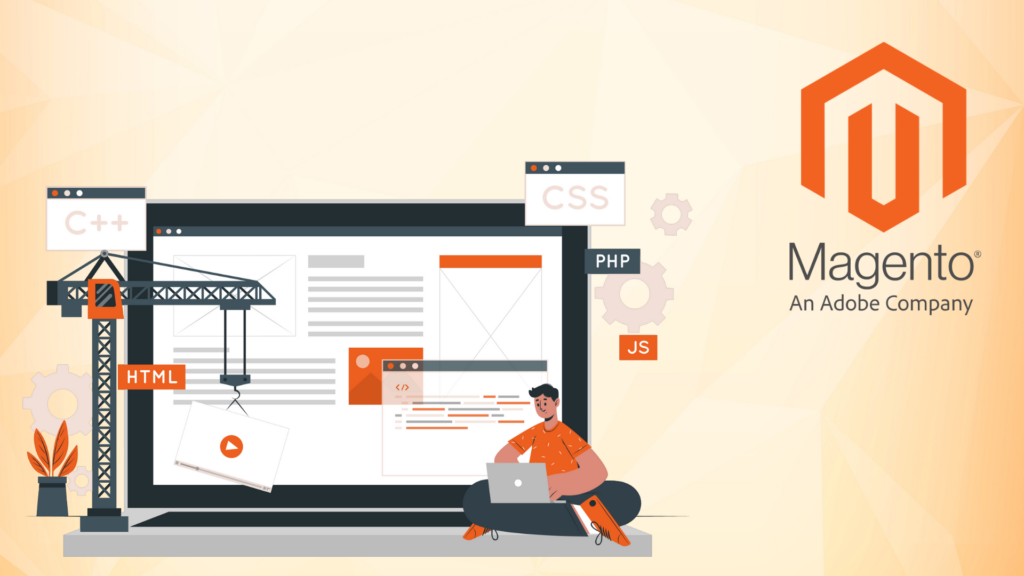
Magento is an eCommerce platform solution owned by Adobe that allows businesses to build and manage online stores. It was originally written on Zend, a PHP framework, and was first released by Varien Inc. on March 31, 2008.
The platform offers robust features, scalability options, customizable templates, and more that allow users to control how their store looks, feels, and functions without compromising the shopping experience. This makes Magento the best eCommerce platform for almost all business sizes.
However, here’s a thing to consider. Just like other eCommerce platforms, Shopify, BigCommerce, and WooCommerce; Magento is not beginner-friendly. It is a complex platform with complex requirements and a steep learning curve, requiring you to hire a Magento developer.
Lastly, if you’ve heard of Magento, you must’ve come across the terms ‘Magento Open Source’ and ‘Adobe Commerce’. So, let’s first have their understanding.
What are Magento Open Source and Adobe Commerce?
Magento Open Source and Adobe Commerce (formerly Magento Commerce) are two different editions of the Magento platform.
Magento open source is the ‘self-hosted’ and free version of the platform, while Magento Commerce is a premium version with added features and benefits. Let’s check how both of these Magento editions differ.
The Difference: Magento Open Source VS. Adobe Commerce
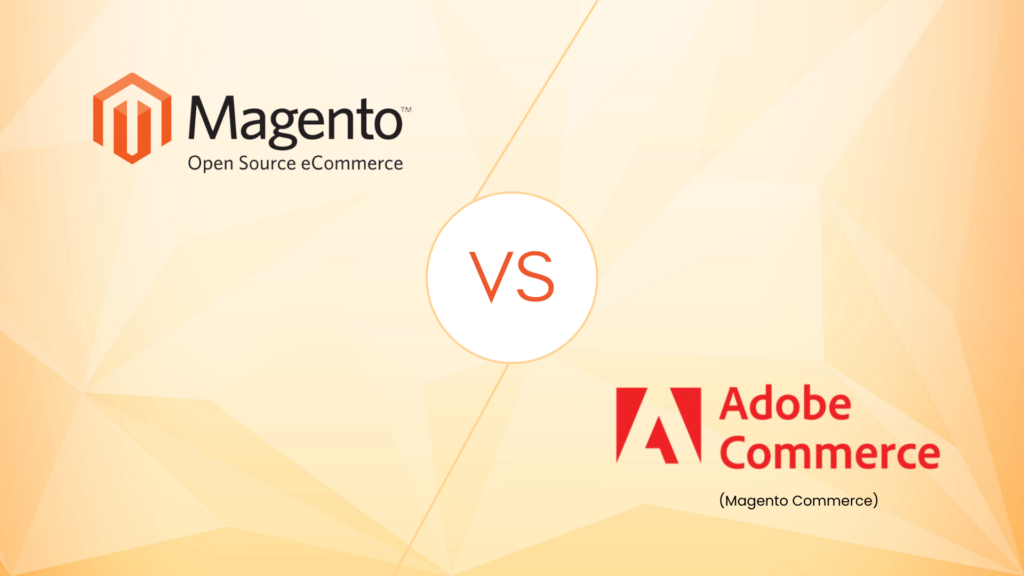
The main difference between Magento Open Source and Adobe Commerce is that they are 2 different versions of the same platform where one is free to use and the other is a paid version.
Here, I’m adding a table to further explain their differences.
| Feature | Magento Open Source | Adobe Commerce |
| Cost | Free | Paid Subscription |
| Hosting | Can be self-hosted with any hosting provider | Requires certified hosting partners or can choose Magento Cloud as a hosting solution |
| Features | Includes core functionalities | A wider range of built-in features and advanced functionalities |
| Customization | It is highly customizable but requires technical expertise and dependency on extensions | It helps with easier customization with a range of drag-and-drop features |
| Scalability | Suitable for smaller to medium businesses | Scalable for high-volume businesses |
| Support | Community support | Community support + 24/7 Dedicated support from Adobe |
| Upgrades | Manual upgrades by users | Upgrades and security patches are handled automatically |
That’s all about the open source and commerce side of Magento.
Now that we’ve understood Magento in-depth, let’s do a feature analysis for the same.
Magento eCommerce Features
In this section, we’ll talk about major Magento eCommerce features that you should be aware of before you choose the right eCommerce platform for your business.
1. Easy to Use
Yes, building an entire store in Magento might indeed be challenging for a non-technical person.
However, for any eCommerce development agency or freelance Magento developer, it is fairly straightforward to build a store on Magento from scratch. It is a widely used eCommerce platform worldwide and has tons of resources online detailing how to use it. Additionally, the Magento community is huge, and developers love to collaborate and share information on tackling issues, be it the most common or most challenging.
Despite its complexity, Magento allows for basic customization, enabling store owners to adjust themes, layouts, and content without needing advanced technical skills.
2. Adaptability and Customization
Magento is highly adaptive and flexible to any kind of customization that you wish to make in your store.
The adaptability factor comes due to its open-source nature that allows developers to customize online stores to a great extent without introducing any limitations. This means the power to make advanced customizations is in the hands of the developer, Magento won’t limit anything. The more experienced and skilled Magento developer you hire, the more chances for you to achieve a truly unique and feature-rich store.
3. Analytics and Reporting
Data and analytics are the most crucial lookouts for any business. So, Magento has pre-integrated Google Analytics with it which helps store owners in tracking eCommerce metrics with ease.
For advanced tracking of analytics, Magento offers a Business Intelligence tool, which is an all-in-one commerce data solution. The tool includes cloud-based hosting, rich visualization capabilities, and robust report-building tools, helping to simplify the process of checking your business health. Its dashboard involves information on;
- Average Order Value (AOV)
- Customer Lifetime Value
- Retention Rates
… And more.
These powerful insights help you personalize the engagement activities across your sales channels and understand which one has more impact on your target audience. Aside from that, it serves as a roof to store your data, providing a dedicated space for analyzing business activities. It also includes a whiteboard feature that helps visualize business growth.
For reporting, Magento offers a variety of pre-built reporting features covering various aspects of your online store’s performance. I’m listing them here.
- Sales report
- Tax report
- Abandoned shopping cart report
- Best viewed products report
- Best purchased products report
- Low stock report
- Search terms report
- Product reviews report
- Coupon usage report
- Total sales invoiced report
These easily accessible reports help you study your business activities thoroughly and make data-driven decisions to optimize your marketing strategies leading to overall improved business performance.
4. Support and Extensions
The support for Magento Open Source depends on a large and active community of developers and merchants. We already mentioned that the Magento Community is huge and developers love to share their knowledge and experience using the platform. So, any time when a developer finds themselves stuck on any issue, they’ve got support and guidance from community members.
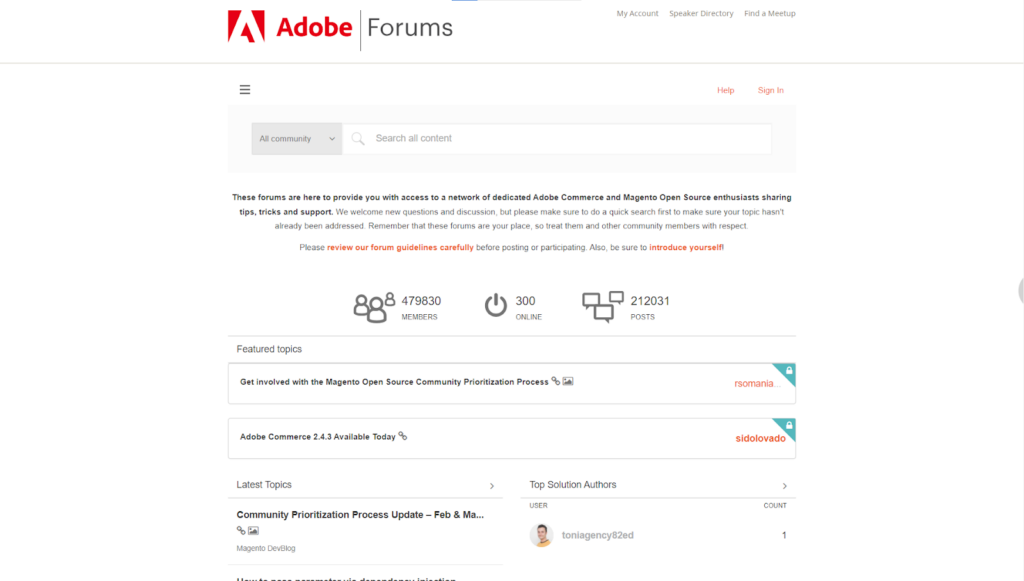
Also, Magento has many resources like forums, documentation, and tutorials that offer solutions and help troubleshoot issues. For Adobe Commerce users, Adobe offers 24/7 chat support, including faster response times, guaranteed uptime SLAs (Service Level Agreements), and access to specialists for complex issues.
Magento resources are great, but sometimes you just need a helping hand. So, you can also go for Magento Support and Maintenance Services from a reliable magento agency. Choosing ongoing service will help prevent conflicts and keep the store running smoothly.
Beyond Magento’s core functionalities, it has a Magento Marketplace where tons of extensions and plugins can be found to extend your online store’s capabilities.
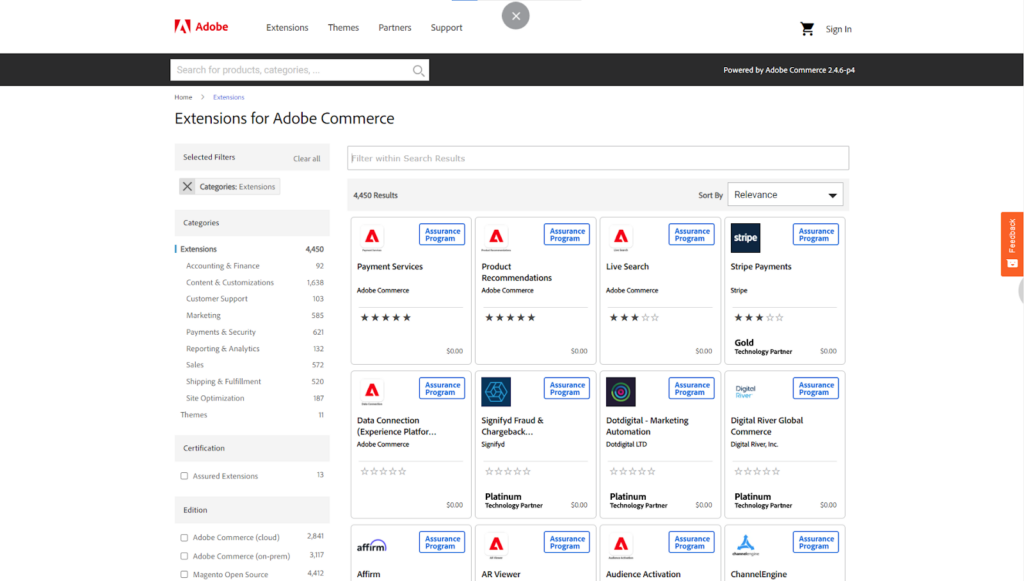
This includes free and paid extensions for a wide array of categories like content management, marketing, SEO, customer service, shipping, and more.
5. Themes and Templates
Customers determine your brand value by the look and feel of your online store, making it necessary for you to invest in better themes and templates. And with Magento, themes and templates are no exception.
Magento comes with a default Luma Theme that has all the basic features and functionalities that you may wish to integrate into your store. However, you can find a variety of third-party themes and templates to adjust the look and feel of your online store through Magento Marketplace.

You can also find themes and templates from various providers across the internet.
Lately, Hyvä Themes have gained popularity in the Magento world for their lightning-fast speed, flexibility, customization capabilities, ease of maintenance, and community support. It comes with a blank canvas where store owners are required to custom-develop the layout and structure of their store.
To reduce the development time with the Hyva theme, Aureate Labs has recently introduced a Hyvä Theme Accelerator, named InstaBuild. InsaBuild for Hyvä offers pre-designed templates and layouts that help reduce significant development time while maintaining the performance flexibility of Hyva themes.
Lastly, if it’s hard to find a theme or a template that matches the aesthetics of your products, you also have the option to custom-develop a theme for your Magento store. A professional and reliable Magento Development Company can help you best with that.
6. Marketing and SEO Tools
Magento understands the importance of search engines and marketing in attracting visitors. To help store owners perform better at marketing and SEO, they’ve several built-in features as well.
I’m listing them right below for better understanding.
Magento Marketing Features:
- Up-selling, cross-selling, and product bundling
- Promotional pricing management
- Coupons management
- New product promotion
- Shipping
- Multi-tier pricing management
- Customizable category landing pages
- Newsletters management
- Abandoned cart recovery
Magento SEO Features:
- URL management
- Google sitemap
- Metadata management
- Compatibility with various search engines
- Customer sorting attributes
- Mobile-friendly design
These built-in marketing and SEO features help you with running targeted campaigns, personalizing the shopping experience, improving SERP rankings, performance optimization, and more.
7. Security
Security is a top priority for any store owner, and Magento recognizes this importance.
The platform offers built-in security features to help reduce security breaches such as data leaks, information theft, fake transactions, malware attacks, and more. Magento employs user authentication and authorization mechanisms to ensure that only authorized individuals have access to the store’s backend.
To further protect your store, the platform utilizes industry-standard encryption protocols, firewall protection, and regularly updates security measures to address emerging threats and vulnerabilities.
For unexpected security incidents, Magento maintains consistent data backups and implements a reliable recovery process. Furthermore, Magento adheres to the Payment Card Industry Data Security Standard (PCI DSS) requirements, ensuring secure payment processing for your customers.
Until now, we discussed some of the top features offered by Magento, but the list doesn’t end here.
There are many other features offered by Magento that help with Multi-site management, Catalog / Inventory management, Order management, Payment and shopping cart options, Mobile Commerce, Customer Relationship Management, and more.
Learn more about Magento Features.
Magento eCommerce Pricing and Costs Associated
We previously mentioned 2 different versions of Magento, Open Source and Adobe Commerce.
And the pricing and costs associated differ for both versions. Here’s an overview of pricing plans for both versions with a detailed breakdown of the initial costs associated.
1. Magento Open Source
Magento Open Source is free to install and build an online store with it.
While there’s no monthly licensing fee with it, you’ll still need to pay for a separate hosting plan to make your store publicly accessible. Additionally, there are other costs involved in setting up and running a Magento Open Source store. Let’s discuss all of them in a table.
| Costs Associated | Approximate Cost |
| Magento Open Source license | $0 |
| Hosting (Yearly) | $720 – $11,000 |
| Domain name | $20 – $200 |
| SSL Certificate (Yearly) | $50 – $600 |
| Custom development | $0 – $6000 |
| Web Design | $0 – $5000 |
| Magento theme | $100 – $500 |
| Magento extensions (2) | $350 – $2,000 |
| Marketing, PPC, and SEO (Monthly) | $300 – $5,000 |
| Payment Providers Fees | 2.9% + $0.30 per transaction (Approx.) |
2. Adobe Commerce
We know that Adobe Commerce is the paid version of the Magento platform and comes with a subscription model. However, they don’t have a fixed pricing plan, instead, you’ll need to submit your details for a customized quote from Adobe Commerce that fits your needs.
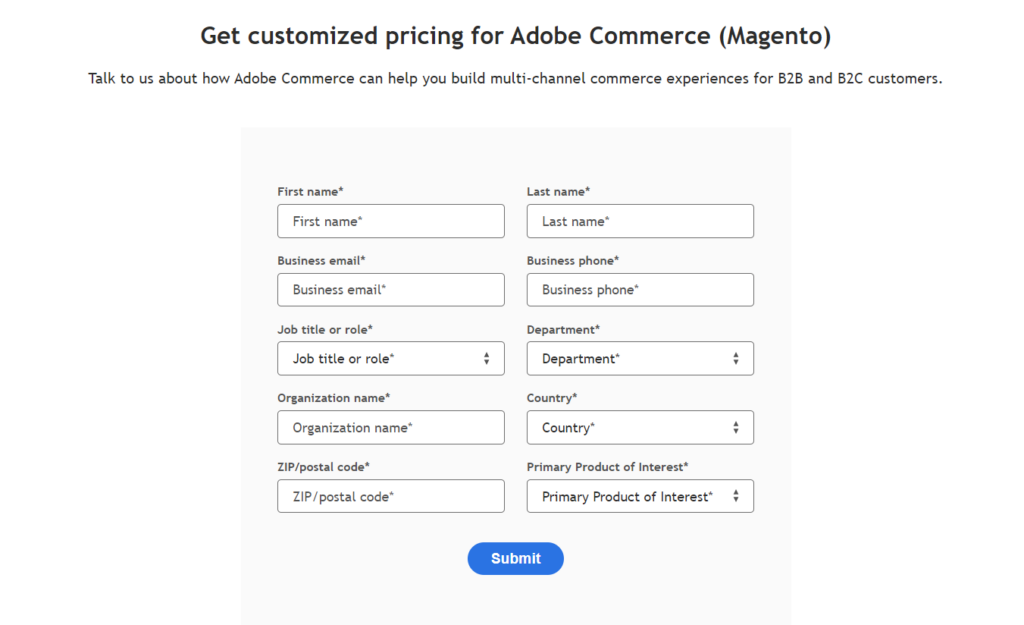
However, we don’t have a fixed subscription plan to present here, I’ve approximated the same and other costs associated with building a store on Adobe Commerce. Let’s put them on a table.
| Costs Associated | Approximate Cost |
| Adobe Commerce license | $22,000 – $125,000 |
| Hosting (Yearly) | $15,000 – $39,000 |
| Domain name | $20 – $200 |
| SSL Certificate (Yearly) | $50 – $600 |
| Custom development | $0 – $20,000 |
| Custom development | $0 – $15000 |
| Magento theme | $500 – $1,000 |
| Magento extensions | $1,000 – $5,000 |
| Marketing, PPC, and SEO (Monthly) | $2,000 – $10,000 |
That’s all about the pricing and costs associated with Magento Open Source and Adobe Commerce.
Many factors influence the cost of building a store on Magento, and if you also want to get an accurate estimation of Magento eCommerce website costs, you can contact Magento experts and they’ll guide you through.
Let’s move forward to understand the potential good and bad side of using Magento.
Magento eCommerce Pros and Cons
Here, I’ve listed the pros and cons of Magento eCommerce.
Pros of working with Magento:
- It’s open-source
- It is flexible and highly customizable
- Has great SEO capabilities
- Provides omnichannel support
- Has a community of experts
- Is mobile-commerce friendly
- Is GDPR and PCI-compliant
- Has great scalability options
- It supports the latest technologies
- Is consistent with updates and improvements
- Includes PWA architecture
- Allows multi-platform integration
… And more.
Cons of working with Magento:
- Can be expensive
- High technical expertise is required
- Comes with a potential barrier of hosting
Now that we have well understood Magento as a platform, let’s further explore some of the best eCommerce websites on Magento.
Magento eCommerce Website Examples
You must be intrigued to see what a website built on Magento would look like. So, here I’ve listed the top 7 eCommerce websites that are built using Magento.
1. Kalki Fashion

2. Cox&Cox

3. Isha Foundation

4. Nestle Nespresso

5. Björn Borg

6. Christian Louboutin

7. Oliver Bonas

You can see how well Magento fits various eCommerce niches.
But these are just a few examples of successful online stores built with Magento. We still need to figure out whether Magento is the right choice for your business.
Let’s talk about that in the next section.
Is Magento the Right Choice for Your Business?
Answer: It depends.
Magento is a powerful eCommerce platform, being used by some of the biggest brands in the world.
If you’re a small business you might be better off with a simpler platform such as Shopify, or WooCommerce. But if you’re a growing business or have a well-established business identity with better resources, Magento is your way to go.
Magento eCommerce FAQs
We have discussed almost all the necessary information about Magento. But it’s natural to have some lingering questions and doubts. In this section, we’ll focus on answering some common hesitations that you may have before making a final decision on getting started with Magento.
1. Is Magento free to use?
Yes and No. Magento has both free and paid versions of its platform. First is the open source edition which includes all the core functionalities to run an online store and is free to use. However, for more advanced features and comprehensive support, you’ll need a paid version like Magento Commerce (Adobe Commerce).
2. How does Magento tackle common eCommerce issues?
Magento is constant with updates and ensures optimal performance for your eCommerce store. Their updates focus on addressing user pain points, such as speed issues, payment problems, and more to keep their eCommerce platform up and running.
3. What are some common challenges faced with Magento?
While Magento is powerful, Magento is also complex to set up and manage compared to other eCommerce platforms that offer simpler interfaces. For small businesses or people with lesser technical know-how, Magento may bring potential hurdles.
4. Is Magento the absolute best eCommerce platform?
Magento is widely considered one of the top eCommerce platforms due to its feature-rich nature, ability to scale with your business, and extensive customization options. However, the “best” platform for you depends on your specific needs.
5. Why is Adobe Commerce so expensive?
Adobe Commerce is expensive as it offers a wealth of enterprise-level features. These include tools like a drag-and-drop page builder, a B2B module for business-to-business transactions, and Adobe Sensei, an AI-powered system that personalizes product recommendations to boost sales.
6. What programming language does Magento use?
Magento is built on PHP and has elements from Zend Framework and the MVC (model-view-controller) architecture. Moreover, Magento incorporates some other open-source technologies alongside PHP to provide a robust and modular structure of the platform.
So, Getting Started with Magento?
Choosing the platform is one of the most important decisions for any eCommerce business.
And we discussed all the necessary areas that you should know about, before making up your mind on getting started with Magento. I hope this article helped you easily understand all the information without leaving you in a state of confusion.
If you still have any lingering questions or doubts, you can comment them down below. We are happy to answer each of your queries and help you choose the right eCommerce solution for your business.






Post a Comment
Got a question? Have a feedback? Please feel free to leave your ideas, opinions, and questions in the comments section of our post! ❤️